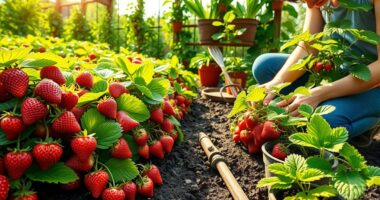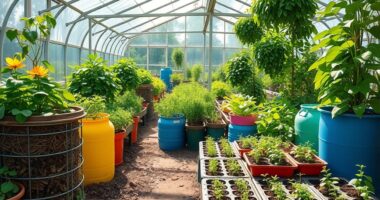For successful zucchini cultivation, I always start with heirloom, non-GMO seeds for better flavor. I make sure to plant them in full sun and well-drained soil with a pH of 6.0 to 7.0. Consistently watering them at the base keeps the foliage dry and healthy. Regularly checking for pests helps to avoid infestations, and harvesting zucchinis when they’re 6-8 inches gives the best taste. Stick with me, and I’ll share even more expert tips that will make your garden thrive!
Key Takeaways
- Choose heirloom and non-GMO seeds suited to your USDA hardiness zone for better flavor and yield.
- Ensure well-drained, nutrient-rich soil with a pH between 6.0 and 7.0 for optimal growth.
- Water at the base to maintain soil moisture while keeping foliage dry and preventing diseases.
- Regularly inspect for pests like squash bugs and use organic control methods to protect plants.
- Harvest zucchinis at 6-8 inches for best flavor and encourage continuous production by picking frequently.
Survival Garden Seeds – Golden Zucchini Seeds for Planting

If you’re a beginner gardener looking to grow something vibrant and delicious, Survival Garden Seeds’ Golden Zucchini Seeds are perfect for you. These non-GMO heirloom seeds produce bush-style plants with bright yellow fruits that are easy to pick! I love how their flavor is similar to green zucchini, making them a delightful addition to any dish. The seeds come with detailed instructions, ensuring you know exactly how to plant and care for them. Plus, they’re sourced in the USA, guaranteeing quality. With high germination success and sturdy growth, I’m excited to see how these beauties will thrive in my garden!
Best For: Beginner gardeners looking for a vibrant and easy-to-grow vegetable variety.
Pros:
- Non-GMO heirloom seeds that produce bright yellow fruits with a flavor similar to green zucchini.
- Comes with detailed planting and care instructions, making it user-friendly for beginners.
- High germination success with sturdy plants that yield abundant produce.
Cons:
- Some customers reported a small quantity of seeds in the packet.
- Maximum germination rate of 50% may not meet everyone’s expectations.
- A few users have yet to plant the seeds, leaving uncertainty about their potential yield.
Islas Garden Seeds Round Zucchini Summer Squash Seeds (40+ Heirloom Seeds)

Islas Garden Seeds Round Zucchini Summer Squash Seeds are perfect for home gardeners seeking a reliable and flavorful addition to their vegetable patch. I love how these heirloom seeds, known as Eight Ball Zucchini, produce a delicious, nutty flavor and high yields—I’ve seen close to 100 squash from a small space! Plant them 1/4 inch deep after the last frost, and they thrive in full sun with moist soil. Germination takes just 7-10 days, making them a quick addition to my garden. Just be mindful of pests and guarantee proper conditions for the best results. Happy gardening!
Best For: Home gardeners looking for high-yield, flavorful summer squash that is easy to grow.
Pros:
- High yields: Users report producing close to 100 squash from small planting areas.
- Quick germination: Seeds typically germinate within just 7-10 days.
- Delicious flavor: The round zucchini offers a unique, nutty taste that enhances various dishes.
Cons:
- Variable germination rates: Some users have experienced poor germination, possibly due to old seeds or other factors.
- Pest concerns: Squash bugs can affect yield and require monitoring.
- Specific growing conditions: Requires full sun and moist soil to thrive, which may not be suitable for all gardens.
Isla’s Garden Dark Green Zucchini Seeds (50+ Heirloom Non-GMO)
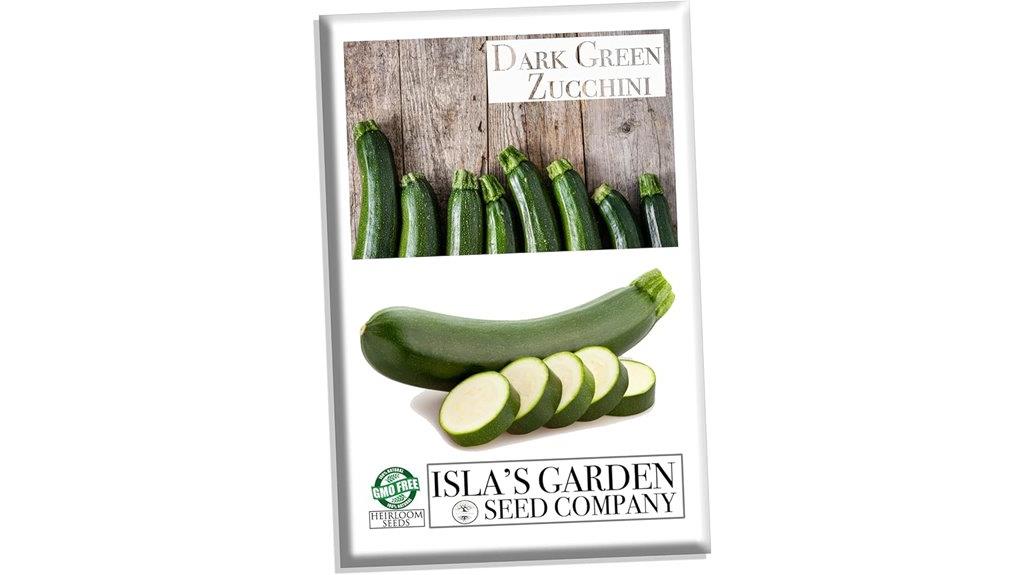
For gardeners seeking a reliable and high-yield summer squash, Isla’s Garden Dark Green Zucchini Seeds stand out as an excellent choice. These heirloom, non-GMO seeds produce a prolific crop of dark green zucchinis with pale green flesh, perfect for sautéing, baking, or grilling. They mature in about 55 days and thrive in USDA hardiness zones 3-12. I love how they grow to 24-36 inches tall, requiring just 36-48 inches of spacing. Plant them in full sun with regular watering, and you’ll enjoy a bountiful summer harvest. Plus, they’re deer resistant, making them a smart addition to any garden!
Best For: Home gardeners looking for a reliable and productive summer squash variety that is easy to grow and versatile in the kitchen.
Pros:
- Heirloom and Non-GMO: These seeds are open-pollinated, ensuring a natural growing experience without genetic modifications.
- High Yield: Produces 6-8 dark green zucchinis per plant, perfect for a plentiful harvest.
- Deer Resistant: Helps protect your garden from wildlife, allowing for a better chance of a successful crop.
Cons:
- Requires Space: Needs 36-48 inches of spacing, which may not be suitable for small gardens.
- Maturity Time: Takes about 55 days to mature, which requires patience for eager gardeners.
- Limited Hardiness Zones: Only suitable for USDA hardiness zones 3-12, potentially limiting for some gardeners in extreme climates.
Home Comforts Pumpkin Zucchini Laminated Poster (20×30 Inch)
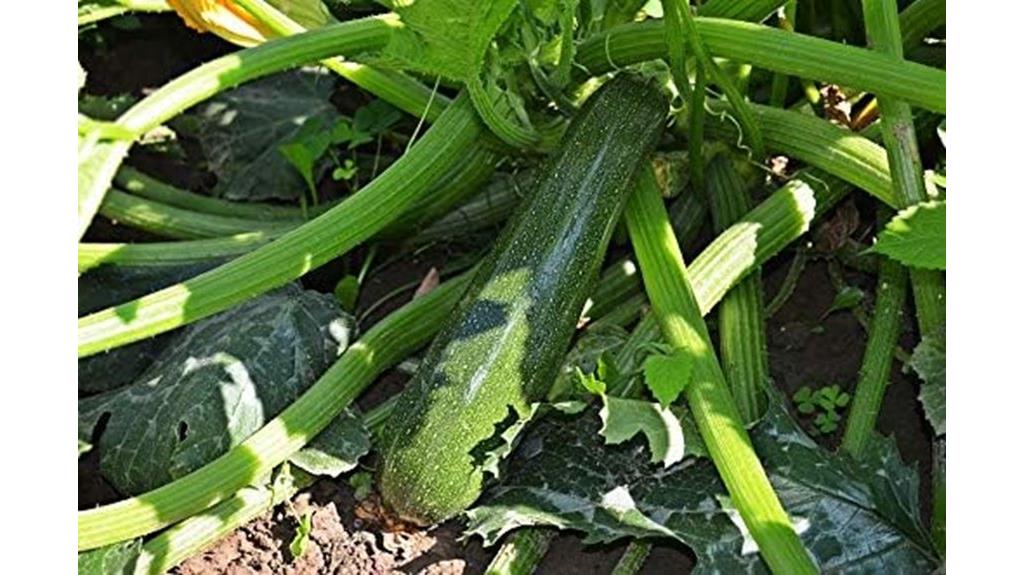
The Home Comforts Pumpkin Zucchini Laminated Poster is perfect for anyone looking to brighten up their home or office with a touch of nature’s bounty. Measuring 20 by 30 inches, its vibrant colors and stunning imagery catch the eye, making it a delightful addition to any decor. I appreciate the high-quality printing that guarantees crisp details and clarity. Plus, the full lamination protects it from dust and liquids, so it stays fresh and beautiful over time. Arriving carefully packaged, it’s ready for framing and display, making it a fantastic gift for fellow gardening enthusiasts or a charming piece for my own space.
Best For: Anyone looking to enhance their home or office decor with vibrant, nature-inspired artwork.
Pros:
- High-quality printing ensures vivid colors and clear details.
- Fully laminated for protection against dust and liquids, preserving its appearance.
- Arrives carefully packaged and ready for framing, making it a convenient gift option.
Cons:
- Limited to a single design, which may not suit everyone’s taste.
- Size may not fit smaller spaces or specific wall dimensions.
- Lamination can increase the price compared to non-laminated posters.
Black Beauty Zucchini Seeds | 20-Count, Heirloom, Non-GMO
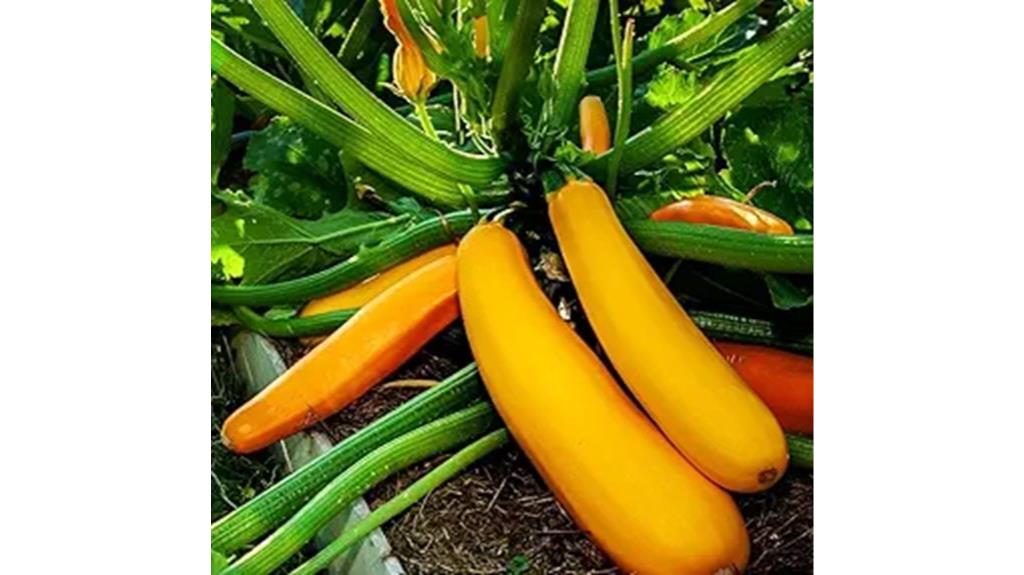
If you’re looking to elevate your home gardening with a reliable and flavorful option, Black Beauty Zucchini Seeds are an excellent choice for both novice and experienced gardeners alike. These heirloom, non-GMO seeds produce glossy, dark fruits that are perfect for a variety of culinary delights—from savory grilled dishes to sweet muffins. Plant them in well-drained soil, ensuring they get plenty of sunlight and water regularly. Expect germination within 7-14 days, and don’t forget to harvest when they reach 6-8 inches. With a little care, you’ll enjoy a bountiful and nutritious harvest in no time!
Best For: Home gardeners looking for a reliable and flavorful zucchini variety that is easy to grow and versatile in the kitchen.
Pros:
- Proven heirloom quality ensures superior taste and performance.
- Produces bountiful harvests of glossy, dark fruits suitable for various dishes.
- Non-GMO and attracts pollinators, contributing to a healthier garden ecosystem.
Cons:
- Requires consistent watering and monitoring for pests, which may be challenging for some gardeners.
- Germination period of 7-14 days may be longer than other seed options.
- Limited to a specific growing season, as they thrive in warmer temperatures and are sensitive to frost.
Factors to Consider When Choosing Zucchini Cultivation

When I think about starting my zucchini garden, I know several key factors can make or break my success. It’s essential to take into account seed variety, the right growing conditions, and effective pest management strategies. Plus, I can’t overlook the importance of soil quality and proper watering methods.
Seed Variety Selection
Choosing the right zucchini seeds can make a significant difference in your garden’s success. I always consider the growth habit of the variety—bush or vining—as it helps me optimize my garden space. Heirloom and non-GMO seeds are often my go-to choices because they usually offer better flavor and disease resistance. I also assess the expected yield; some varieties can produce up to 100 squash in a small area, which is impressive! Germination rates are another factor; some seeds sprout in just 2-4 days, while others can take up to 10. Finally, I make certain to choose varieties suited to my USDA hardiness zone to guarantee they thrive throughout the growing season. Happy gardening!
Growing Conditions Requirements
After selecting the right seeds, understanding the growing conditions for zucchini can take your gardening to the next level. Zucchini thrives in full sun, so make sure your plants get at least 6-8 hours of direct sunlight each day. The ideal soil should be well-drained, rich in organic matter, and have a pH level between 6.0 and 7.0. Zucchini prefers warm temperatures, ideally between 70°F and 85°F, so protect them from frost. Don’t forget about spacing; I recommend placing your plants 36-48 inches apart for best air circulation and root development. Finally, keep the soil consistently moist with 1-2 inches of water per week, focusing on watering at the base to prevent fungal diseases. Happy gardening!
Pest Management Strategies
Although pests can be a gardener’s worst nightmare, implementing effective management strategies can help protect your zucchini plants and guarantee a bountiful harvest. I make it a point to rotate my crops and use intercropping to disrupt pest life cycles. Regular inspections are essential; I always check for signs of squash bugs and vine borers, as they can quickly damage my yield. I also rely on physical barriers like row covers to shield young plants while still allowing light and moisture in. Introducing beneficial insects, like ladybugs and lacewings, creates a balanced ecosystem. If pest populations become overwhelming, I resort to organic pesticides or insecticidal soaps, ensuring they’re safe for the environment and won’t harm beneficial organisms.
Soil Quality Importance
Soil quality plays an essential role in the success of my zucchini cultivation, as it directly impacts plant health and yield. I’ve learned that zucchini thrives in well-drained, nutrient-rich soil, which supports robust root development. The ideal soil pH for optimal growth ranges between 6.0 and 7.0, allowing for better nutrient absorption. I always add organic matter like compost to enhance soil fertility and structure, promoting moisture retention and encouraging microbial activity. Regular soil testing helps me determine nutrient levels, guiding my fertilization strategies to meet my zucchini’s needs. It’s important to maintain soil moisture while avoiding waterlogged conditions, since zucchini roots are sensitive to both drought and excess wetness. Good soil quality truly makes all the difference in my garden!
Watering and Irrigation Methods
When it comes to watering and irrigation methods for zucchini, I’ve learned that consistency is key to achieving healthy plants and a bountiful harvest. Zucchini plants thrive on 1-2 inches of water per week, whether from rainfall or irrigation. I always water at the base of the plants to keep the foliage dry, which helps prevent fungal diseases and pests. I find drip irrigation systems to be particularly effective, as they deliver water directly to the roots, reducing waste and promoting deeper growth. During dry spells, I check soil moisture regularly because zucchini are sensitive to both overwatering and underwatering. Plus, I like to mulch around my plants to retain moisture, suppress weeds, and maintain a stable soil temperature.
Harvest Timing Guidelines
To maximize your zucchini harvest, it is essential to know the right timing for picking the fruits. Zucchini usually matures in 45-55 days, depending on the variety and growing conditions. I’ve found that harvesting when the fruits are 6-8 inches long yields the best flavor and tenderness; larger zucchinis can become tough and seedy. Regularly picking them encourages the plant to produce even more. I always check for ripeness by feeling the skin’s firmness and looking for that glossy appearance. For the freshest taste and texture, I prefer to harvest in the morning when it’s cooler. This way, I guarantee my zucchinis stay crisp and delicious for my favorite dishes!
Nutritional Benefits of Zucchini
Although many people enjoy zucchini for its versatility in cooking, its nutritional benefits make it an even more appealing choice for cultivation. I love that a medium-sized zucchini contains just about 33 calories, making it perfect for anyone watching their weight. It’s packed with essential vitamins like vitamin C, which boosts the immune system and supports skin health, and vitamin A for good vision.
Zucchini also offers a good dose of dietary fiber, promoting digestive health and preventing constipation. Plus, it’s loaded with antioxidants such as lutein and zeaxanthin, which may help protect against age-related eye diseases. With around 95% water content, zucchini keeps us hydrated, making it a fantastic addition to any garden.
Frequently Asked Questions
How Much Sunlight Do Zucchini Plants Need Daily?
Zucchini plants thrive on sunlight, and I’ve found they need about six to eight hours of direct sunlight each day. When I position them in a sunny spot, I notice they grow stronger and produce more fruit. If they don’t get enough light, the plants can become leggy and yield fewer zucchinis. So, make sure to give them plenty of sun for a bountiful harvest. Trust me, it makes all the difference!
What Pests Commonly Affect Zucchini Plants?
In the garden of life, pests can feel like uninvited guests at a feast. When I grow zucchini, aphids, squash bugs, and cucumber beetles often crash the party. These little villains can suck the life out of my precious plants. I’ve learned to keep a close eye on them, using traps and natural predators to defend my garden. By staying vigilant, I guarantee my zucchini flourish and thrive, unbothered by these nuisances.
When Is the Best Time to Harvest Zucchini?
I usually harvest zucchini when they’re about six to eight inches long. That’s when they’re tender and packed with flavor. If I wait too long, they can become large and tough, losing their appeal. I check my plants every couple of days during the growing season, ensuring I pick them at their peak. It’s really satisfying to gather fresh zucchini and add it to my meals right from the garden!
Can Zucchini Plants Be Grown in Containers?
Absolutely, zucchini plants can thrive in containers! I’ve grown them this way myself, and it’s been a rewarding experience. Just make sure you choose a large enough pot—at least 5 gallons—and use good quality potting soil. I’ve found that placing the container in a sunny spot helps them flourish. Regular watering and fertilizing keep them happy too. Trust me, container gardening can lead to a bountiful zucchini harvest!
How Do I Store Harvested Zucchini for Freshness?
Storing harvested zucchini is like preserving a moment in time. I wash them gently, then let them dry completely. I wrap each one in a paper towel, which absorbs excess moisture, and place them in a breathable bag. I keep them in the fridge’s crisper drawer, where they stay fresh for about a week. By treating them thoughtfully, I guarantee that each zucchini retains its flavor, ready to brighten my meals.
Conclusion
In my own garden, I once planted a single zucchini seed that grew into a sprawling plant, yielding more than I could ever imagine. Just like nurturing that seed, successful zucchini cultivation requires the right conditions and care. By choosing the best seeds and paying attention to key factors, you can transform your garden into a bountiful haven. Embrace the journey, and before you know it, you’ll be harvesting your own garden marvels. Happy gardening!


